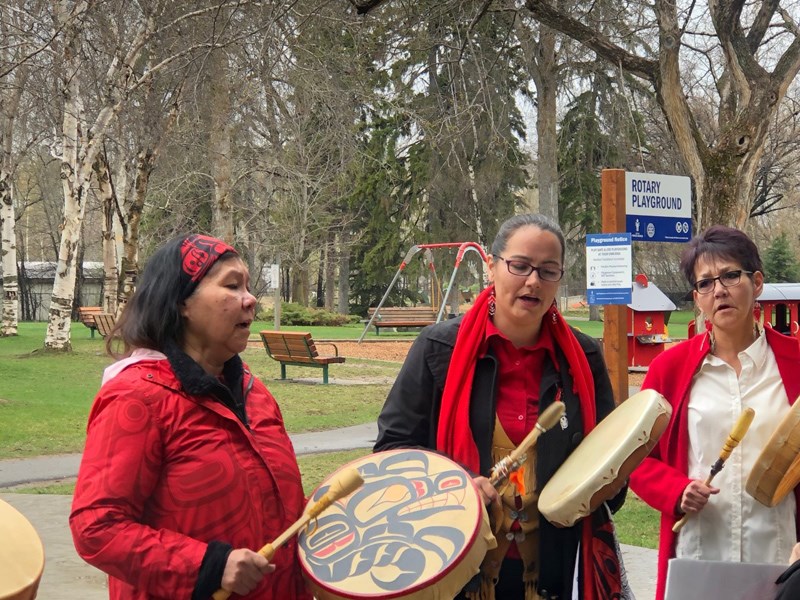Members of the governing body of the Highway of Tears gathered in Prince George’s Lheidli T’enneh Memorial Park to announce a new project that will commemorate the lives lost along Highway 16.
Announced on May 5, the National Day of Awareness for Murdered and Missing Indigenous Women and Girls, the project will be called Pillars of Hope and Strength.
Two unique pillars will be made of local red cedar and will be carved on each of their four sides by local Indigenous artists wo will be guided by the creative direction of renowned Haida artist and carver, Keith Kerrigan.
The Pillar of Hope will be located in Prince George, at one end of the Highway of Tears, while the Pillar of Strength will reside in Prince Rupert, at the other end of Highway 16.
“We come together to bring awareness to the murdered and missing women and young girls and sometimes young men,” said Lheidli T’enneh Elder Darlene McIntosh, during the opening prayer at the announcement ceremony.
“The heartache sorrow for families and friends and all of our first Nations community and non-First Nations community has been overwhelmingly sad.”
A key element to the pillar’s creation is the opportunity they will provide for family members and those impacted by the loss of women and girls along the Highway of Tears to have a quite place to visit and reflect.
The pillars are anticipated to be raised in both communities in the fall of 2022.
“In the last six months my cousin’s daughter, Heather Abraham - my first cousin - her daughter, Carmelita, was murdered in Quesnel and during this pandemic it is still happening. Women are still going missing and being murdered,” said B.C. Assembly of First Nations Regional Chief Terry Teegee.
“It is a stark reminder today and I am glad to see that slowly but surely things are changing but they can’t happen soon enough so that a situation, within my family with Carmelita, never happens again.”
Once completed, the raising of the pillars will be followed by two 'Letting Go' ceremonies, one in each community, to honour the lives lost and to offer families the opportunity for further healing.
“What I would like to say is that never give up hope please for the missing. I have heard from some mothers and some sisters talking yesterday and they never had closure. They never did find their loved ones and that is the hardest thing in the world,” said Matilda Wilson, whose sixteen-year-old daughter Ramona went missing from Smithers in 1994. Ramona's body was later discovered in a woody area near the airport.
“For 10 months, my daughter was missing, and they finally found her. Imagine how the mothers, sisters, and families are feeling because they never had closure.”
“I think auntie Matilda brought up something critically important,” said event emcee Joni Conlon, referring to the Pillars of Hope and Strength.
“This will be a ceremony to mourn because, in our culture a year after death we have the headstone but many of our families have not had that. What an honour to be able to host a Letting Go ceremony at each of the sites.”
The pillars project is supported by the Highway of Tears Governing Body, which was created as a result of the 2006 Highway of Tears Recommendations Report.
This report was based on input from families of the victims, nation members, Indigenous leaders, and government representatives who attended the Highway of Tears Symposium to bring national awareness and action plans to the deaths and atrocities committed against Indigenous women and girls along Highway 16.
“I know we are bringing attention to this issue and the reason there has been a focus on women and girls is because that is was what was coming to us,” said Brenda Wilson, Ramona’s sister, and a founding member of the governing body.
“We were dealing with our loved ones that were missing and they were female, but today we also recognize the men and boys. There are many of them that are also missing and have been murdered and we address that. For us to tackle this problem it is going to take all genders. We are going to have to work together.”
She added that she’s happy to see this project come to light along with many other important initiatives underway to ensure that murdered and missing women like her sister Ramona are never forgotten.
Additionally, Wilson is a member of the Prince George Red Dress Society, who also announced on May 5 they will be installing a life-sized red dress monument on the corner of Highway 16 and Ferry Avenue, with the design to be unveiled in September.
The gathering concluded with a closing prayer from McIntosh and a closing song performed by the Khast’an Drummers.


.png;w=120;h=80;mode=crop)
